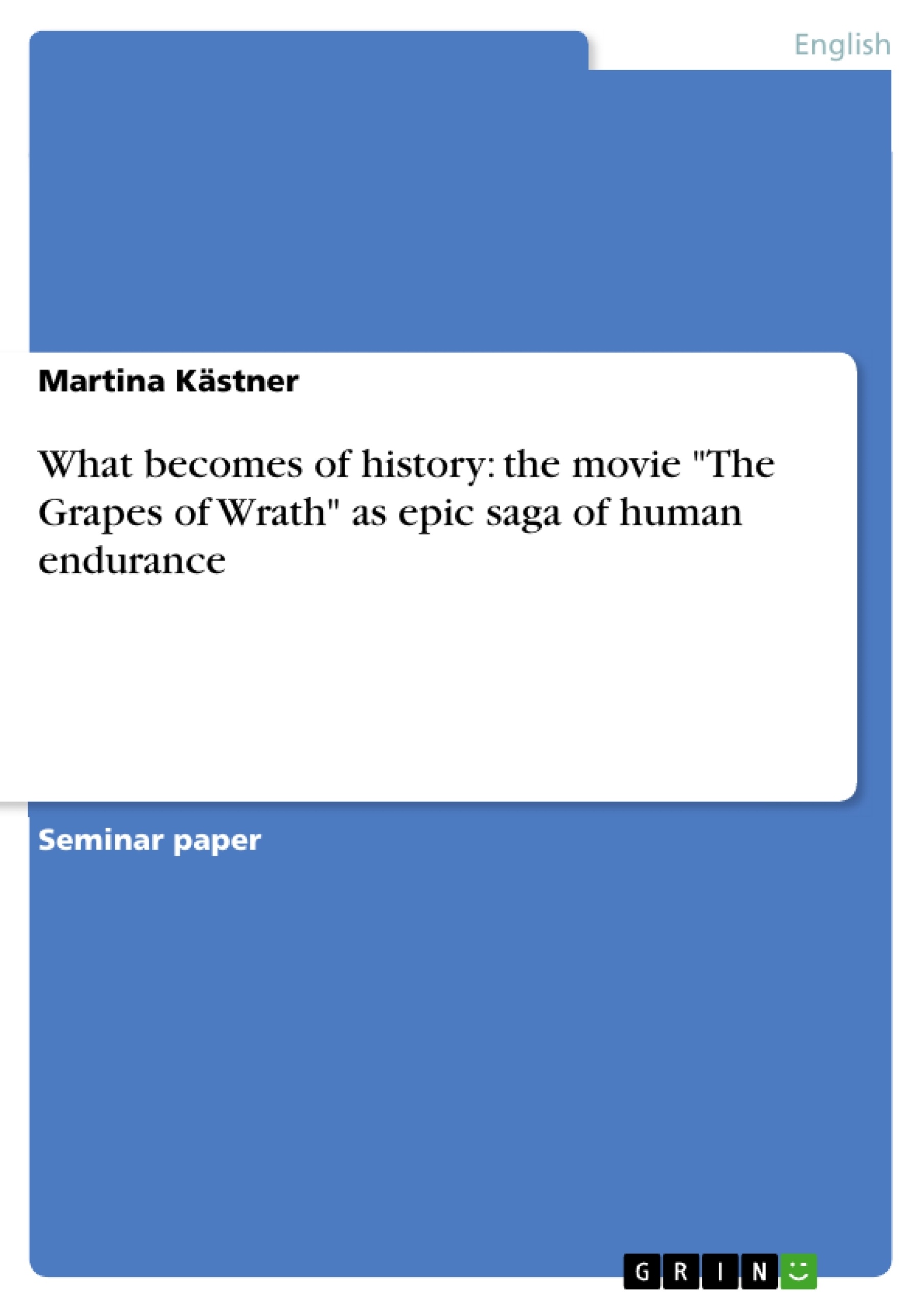In 1936 Steinbeck was commissioned by a San Francisco newspaper to write a series of articles about the migrant farmers who had lost the land they had worked on in the region of the Dust Bowl and who therefore came to California to find work and to start a new life. Steinbeck travelled to the region and witnessed the hardships those farmers had to endure with his own eyes. He was deeply moved by their fate and wanted to help them. Interestingly, he decided that instead of writing newspaper articles about them, he was going to write a novel. Steinbeck thus chose a fictional medium over a documentary one to inform the public about a highly topical subject. His novel The Grapes of Wrath was made into a film only one year after it had been published in 1939. The movie, which carried the same title, was immensely successful and won the director John Ford an Oscar Award. Thus Steinbeck succeeded in drawing attention to the hard lot of the migrant farmers. “What becomes of history?” is the first part of the title for my paper. I take this to refer to the relationship between historical reality and its depictions in literary an cinematic works of art (and not to a mere tracing of historical details in an otherwise fictional piece of art). I think I am justified in doing so, because that seems to be the striking particularity of the book’s creation: Steinbeck obviously thought the novel, which is usually associated with fiction, to be a better medium to convey historical reality than a classical medium of documentary nature like a news article in a newspaper. The same particularity applies to the movie, which is not a documentary. Since success proved both, Steinbeck and Ford, right, the interesting question is: How and why can works of art convey historical reality and how is this done in the movie The Grapes of Wrath? In order to answer this question, I will briefly recount in the first chapter the historical events Steinbeck’s book and Ford’s movie are based on. I will then proceed in the second chapter to give a summary of the plot of the movie that is set in the historical reality described in the first chapter. Also in the second chapter, there will be an analysis of the movie in terms of saga and then epic saga as well as a discussion of how its main theme human endurance is borne out. [...]
Table of Contents
- Introduction
- The historical facts the movie is based on
- Summary of the plot and characterization of the movie as an epic saga of human endurance
- Summary of the plot
- The movie as a saga
- The saga as epic
- The theme of the movie: human endurance
- Assessment of how historical reality is present and presented in the movie
- The immediate historical level of reality
- The exemplifying level
- The symbolic level
- The (in)validity of the representation / interpretation distinction and the power of art
- The power of art
- The (in)validity of the representation / interpretation-distinction
- Conclusion: What does become of reality in The Grapes of Wrath?
Objectives and Key Themes
This paper explores the relationship between historical reality and its portrayal in literary and cinematic works of art, specifically focusing on John Ford's film adaptation of John Steinbeck's novel "The Grapes of Wrath". It aims to analyze how the movie utilizes the medium of film to convey historical reality and to determine the validity of the representation/interpretation distinction in artistic depictions of history.
- The historical context of the Dust Bowl and the Great Depression
- The portrayal of human endurance in the face of adversity
- The role of art in conveying historical reality
- The relationship between representation and interpretation in artistic depictions of history
- The power of film as a medium to communicate historical experiences
Chapter Summaries
The first chapter provides an overview of the historical events that serve as the backdrop for the movie, including the Dust Bowl, the Great Depression, and the resulting migration of tenant farmers to California. The second chapter delves into a summary of the film's plot, highlighting the Joad family's journey west and the hardships they face. This chapter further analyzes the film's characteristics as an epic saga, focusing on its themes of human endurance and resilience. The third chapter examines the various levels at which historical reality is present and presented in the movie, analyzing how the film blends historical details with fictional narrative elements. The fourth chapter explores the broader relationship between documentary representation and artistic depiction of reality, discussing the potential for artistic works to convey historical truths while simultaneously interpreting and shaping them.
Keywords
The primary keywords and focus topics of this paper include the Dust Bowl, the Great Depression, human endurance, epic saga, representation, interpretation, artistic depiction, historical reality, and John Ford's film adaptation of John Steinbeck's "The Grapes of Wrath". These keywords encompass the historical context, key themes, and theoretical frameworks explored within the analysis.
- Quote paper
- Martina Kästner (Author), 2006, What becomes of history: the movie "The Grapes of Wrath" as epic saga of human endurance, Munich, GRIN Verlag, https://www.grin.com/document/64686



